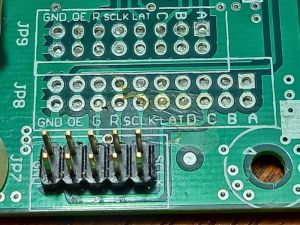ScarlettScroller: Difference between revisions
No edit summary |
|||
| Line 16: | Line 16: | ||
The boards are connected through a 10 pin connector and a 5V power connector. | The boards are connected through a 10 pin connector and a 5V power connector. | ||
=== | === Control connector === | ||
[[File:lichtkrant_flok_jp7.jpg|thumb|right|Lichtkrant connector]] | [[File:lichtkrant_flok_jp7.jpg|thumb|right|Lichtkrant connector]] | ||
| Line 44: | Line 30: | ||
* pin 9: GND | * pin 9: GND | ||
* pin 10: GND | * pin 10: GND | ||
Unfortunately the connector does not seem to carry 5V. If that were the case, a replacement microcontroller could be powered directly from the connector, with the main power entering through the 5V power plug. | |||
=== Power === | |||
The control board is powered by a 12V supply and probably contains a step-down converter to turn it into 5V internally. | |||
== Theory of operation == | |||
There are 80 pixels horizontally and 10 serial-parallel chips with 8 outputs each, | |||
so one row of pixels can be kept in the shift registers. | |||
The 3-to-8 decoder selects one particular row to light, through pins A/B/C. | |||
The MOSFETs are used as drivers. | |||
The SCLK signal goes to the CLK input of all serial-parallel SNHC164 chips. | |||
The LED board is prepared to be used with R+G LED modules, however this particular board does not have the shift register populated for the dual-color. | |||
It appears there is no 'latch' signal, although the controller board has the text 'LAT'. | |||
A latch signal could activate the row data after it's been written to the shift registers, thereby avoiding the pixels showing up already as they're being written and reducing the contrast. | |||
Revision as of 08:53, 23 March 2022
This page is about a lichtkrant, brought by flok.
Hardware
It has 16 elements of 5x8 LEDs each, for a total of 80x8 LEDs. This particular board has monochrome LEDs only.
The electronics consist of two boards: a controller board and a LED board.
The LED board has the following ICs:
- SN74HC138: 3-to-8 line decoder/multiplexer
- SN74HC04: 6 inverters
- 10x SN74HC164: 8-bit parallel-out serial shift registers
- 4x APM4953: dual P-Channel Enhancement Mode Mosfet
The boards are connected through a 10 pin connector and a 5V power connector.
Control connector
Pinout:
- pin 1: SCLK
- pin 2: SCLK (shorted to pin 1)
- pin 3: G = 'green' data bit shifted into row, goes through inverter 6
- pin 4: R = 'red' data bit, goes through inverter 1
- pin 5: A = row select
- pin 6: B = row select
- pin 7: C = row select
- pin 8: D = not clear what this is, perhaps this is just another bit for the row selector, not actually used for this particular board
- pin 9: GND
- pin 10: GND
Unfortunately the connector does not seem to carry 5V. If that were the case, a replacement microcontroller could be powered directly from the connector, with the main power entering through the 5V power plug.
Power
The control board is powered by a 12V supply and probably contains a step-down converter to turn it into 5V internally.
Theory of operation
There are 80 pixels horizontally and 10 serial-parallel chips with 8 outputs each, so one row of pixels can be kept in the shift registers.
The 3-to-8 decoder selects one particular row to light, through pins A/B/C. The MOSFETs are used as drivers.
The SCLK signal goes to the CLK input of all serial-parallel SNHC164 chips.
The LED board is prepared to be used with R+G LED modules, however this particular board does not have the shift register populated for the dual-color.
It appears there is no 'latch' signal, although the controller board has the text 'LAT'. A latch signal could activate the row data after it's been written to the shift registers, thereby avoiding the pixels showing up already as they're being written and reducing the contrast.
